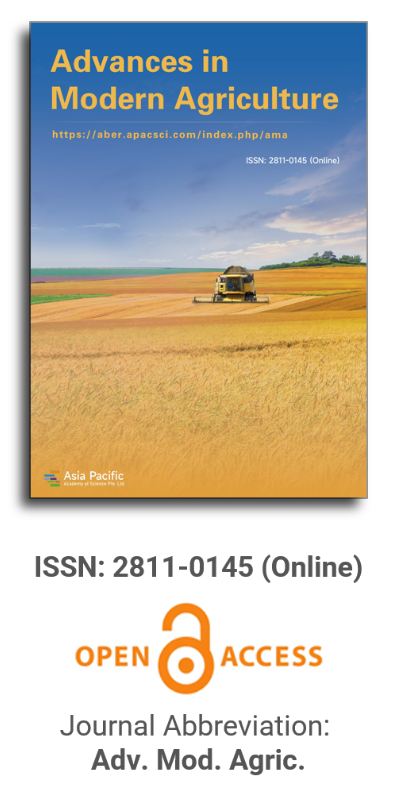


Econometric analysis of resource-use efficiency and profitability in cowpea-based farming systems of Ondo State, Nigeria
Vol 6, Issue 2, 2025
VIEWS - 581 (Abstract)
Download PDF
Abstract
This study assessed the efficiency of resource use and profitability in cowpea-based farming systems among smallholder farmers in Ondo State, Nigeria. Data were collected from 160 respondents using a multistage sampling technique and a structured questionnaire. Analytical tools included descriptive statistics, gross margin analysis, and a Cobb-Douglas production function estimated via Ordinary Least Squares (OLS). Results indicated that cowpea production is highly profitable, yielding a return on investment (ROI) of 4.26, meaning that every ₦1 invested generates ₦4.26 in return. The gross margin and net profit per hectare were ₦932,881.08 and ₦885,100.39, respectively. The Cobb-Douglas model showed that farm size, fertilizer, cowpea seed, and agrochemicals significantly and positively influenced output, whereas labor had a significant negative effect. The estimated returns to scale (0.43) suggested decreasing returns to scale. Further analysis of Marginal Value Product (MVP) and Marginal Factor Cost (MFC) revealed underutilization of land and agrochemicals, and overapplication of labor. Major constraints identified included high transportation costs, price instability, environmental hazards, and limited access to capital and market information. The study concludes that while cowpea farming remains economically viable, addressing technical inefficiencies and systemic barriers is essential for enhancing productivity and profitability.
Keywords
References
1. Oluwole IO, Attama PI, Onuigbo FN, Atabo I. Agriculture: a panacea to economic growth and development in Nigeria. Journal of Economics and Allied Research. 2021; 6(2): 134-146.
2. Osai-Azubuike V, Nwogwugwu U, Nwokoye E. The Role of Agriculture in Economic Development: in Nigeria. Journal of International Economic Relations and Development Economics. 2023; 3(2): 103-111.
3. Panzeri D. A Bioprospecting Multidisciplinary Approach to Valorise Biodiversity: The Case of Bowman-Birk Protease Inhibitors in Vigna unguiculata (L.) Walp [PhD thesis]. University of Milan-Bicocca; 2023.
4. Alabi TT. Variation in Response of Cowpea (Vigna unguiculata L. Walp.) Genotypes to Inoculant and Phosphorus Applications for Seed Yield Improvement [Master’s thesis]. Kwara State University; 2024.
5. Ajeigbe HA, Singh BB, Ezeaku IE, et al. On-farm evaluation of improved cowpea-cereals cropping systems for crop-livestock farmers: Cereals-cowpea systems in Sudan savanna zone of Nigeria. African Journal of Agricultural Research. 2010; 5(17): 2297-2304.
6. Issoufa BB, Ibrahim A, Abaidoo RC. Agronomic and economic benefits of integrated nutrient management options for cowpea production. Experimental Agriculture. 2020; 56(3): 440-452. doi: 10.1017/s0014479720000071
7. Bello TO, Oguntade AE, Afolayan TT. Profitability and Efficiency of Cassava Production in Ekiti State, Nigeria. Agriculture Archives. 2025; 4(1): 10-19. doi: 10.51470/agri.2025.4.1.10
8. Ijigbade JO, Olutumise AI, Toluwase SOW, et al. Assessing the efficiency and profitability potentials of honey input supply: The case of South West Nigeria. Tropical Agriculture. 2023; 100(4): 351-364.
9. Olutumise AI, Bankole AS, Olutumise BO, et al. Gender differential in allocative efficiency of oil palm processors in Southwest, Nigeria. Kasetsart Journal of Social Sciences. 2023; 44(2). doi: 10.34044/j.kjss.2023.44.2.02
10. Ogundari K. Determinants of profit efficiency among small-scale rice farmers in Nigeria: A profit function approach. Research Journal of Applied Sciences, Engineering and Technology. 2013; 5(3): 262-267.
11. Olutumise AI, Ekundayo BP, Omonijo AG, et al. Unlocking sustainable agriculture: climate adaptation, opportunity costs, and net revenue for Nigeria cassava farmers. Discover Sustainability. 2024; 5(1). doi: 10.1007/s43621-024-00249-8
12. Singh BB, Ajeigbe HA. Improved cowpea-cereals-based cropping systems for household food security and poverty reduction in West Africa. Journal of Sustainable Agriculture. 2007; 19(1-2): 25-41. doi: 10.1300/J411v19n01_08
13. Ilesanmi JO, Bello TO, Oladoyin OP, et al. Evaluating the Effect of Microcredit on Rural Livelihoods: A Case Study of Farming Households in Southwest Nigeria. International Journal of Economic, Finance and Business Statistics. 2024; 2(5): 289-302. doi: 10.59890/ijefbs.v2i5.2619
14. Ajeigbe HA, Kamara AY, Chikoye D. Improved Legume-cereal based cropping systems for improved productivity and natural resource management by resource-poor crop-livestock farmers in West Africa. In: Proceedings of the International Research on Food Security, Natural Resource Management and Rural Development; 2008.
15. Beye A, Diakhate PB, Diouf O, et al. Socio-Economic Constraints of Adopting New Cowpea Varieties in Three Agro-Ecological Zones in the Senegalese Peanut Basin. Sustainability. 2022; 14(21): 14550. doi: 10.3390/su142114550
16. Nwagboso C, Andam KS, Amare M, et al. The economic importance of cowpea in Nigeria trends and Implications for achieving agri-food system transformation. Intl Food Policy Research Institute; 2024.
17. Anthony L, Ebukiba ES, Alabuja FO. Differentials in profitability and efficiency of cowpea marketing in rural, semi-urban and urban markets in Nasarawa State, Nigeria. American International Journal of Agricultural Studies. 2023. 7(1): 20-31. doi: 10.46545/aijas.v7i1.287
18. Oladoyin OP, Bello TO, Akinrotimi AF, et al. Assessing the profitability and choice of feed-type determinants in egg production: Evidence from Ondo State, Nigeria. Innovare Journal of Agricultural Science. 2025; 13(2).
19. Saka JO, Agbeleye OA, Ayoola OT, et al. Assessment of varietal diversity and production systems of cowpea (Vigna unguiculata (L.) Walp.) in Southwest Nigeria. Journal of Agriculture and Rural Development in the Tropics and Subtropics. 2018; 119(2): 1–14. doi: 10.17170/kobra-2018121864
20. Afe AI, Nuruden K, Yaman U. Evaluation of growth and yield of cowpea (Vigna unguiculata L.Walp) cultivars and sorghum (Sorghum bicolor L. Moench) with their competitive behavior in cowpea-sorghum intercropping. Badeggi journal of agricultural research and environment. 2023; 5(1): 35-48. doi: 10.35849/bjare202301/86/004
21. Krejcie RV, Morgan DW. Determining Sample Size for Research Activities. Educational and Psychological Measurement. 1970; 30(3): 607-610. doi: 10.1177/001316447003000308
22. Kamara AY, Ekeleme F, Omoigui LO. Influence of planting date on some agronomic traits of cowpea genotypes in the Sudan savanna of Nigeria. African Journal of Agricultural Research. 2009; 4(6): 571-577.
23. Ayanwale AB, Ariyo OC, Ogunlade I. Socio-economic determinants of cowpea production among small-scale farmers in Oyo State, Nigeria. Journal of Agricultural Extension. 2016; 20(2): 104–113.
24. Amaza PS, Bila Y, Iheanacho AC. Identification of factors that influence technical efficiency of food crop production in West Africa: Empirical evidence from Borno State, Nigeria. Journal of Agriculture and Rural Development in the Tropics and Subtropics. 2006; 107(2): 139-147.
25. Ajeigbe, Hakeem A, et al. Effect of different cowpea-cereal row to row planting systems and insecticide sprays of cowpea on the quality of the crop residues. 2007; 1057-1061.
26. Olubunmi-Ajayi TS, Akinrinola OO, Ibrahim A, et al. Assessing technical, economic, and allocative efficiencies of maize-rice-based farmers across scale economies in Southwest Nigeria. Agriculture Archives: An International Journal. 2025; 4(1): 01-09.
27. Moyofolorun Opeyemi Adeyeye, Olaniyi Oluwatosin Ojo, Tolulope Seun Olubunmi-Ajayi, et al. Optimizing resource-use efficiency of yam producers in Ondo state, Nigeria: a path to enhanced food production. International Journal of Advanced Economics. 2024; 6(4): 124-138. doi: 10.51594/ijae.v6i4.1074
28. Oladoyin OP, Olubunmi-Ajayi TS, Adeyeye MO, et al. Effect of the Anchor Borrowers Programme (ABP) on rice production in Ekiti State, Nigeria. Science. 2024; 7(3): 56–69.
29. Afolayan TT, Olutumise AI, Oguntade AE, et al. Herdsmen-farmer conflicts and their effects on agricultural productivity and rural livelihoods. International Journal of Agricultural Science, Research & Technology (IJASRT) in Extension & Education Systems. 2024; 14(4): 261-273.
30. Akinbola AE, Olubunmi-Ajayi TS, Ijigbade JO, et al. Market concentration and efficiency’s determinants of tomato production in Oyo State, Nigeria. International Journal of Applied Research in Social Sciences. 2023; 6(7): 1333-1345. doi: 10.51594/ijarss.v6i7.1278
31. Oparinde LO, Olutumise AI, Adegoroye A. Does Agroforestry Technology Adoption Affect Income Inequality among Arable Crop Farmers in Southwest, Nigeria? A Gender Perspective. Sarhad Journal of Agriculture. 2023; 39(4). doi: 10.17582/journal.sja/2023/39.4.848.860
32. Olubunmi-Ajayi TS, Amos TT, Borokini EA, et al. Profitability and technical efficiency of maize-based cropping system farmers in Ondo State, Nigeria. International Journal of Agricultural Science, Research & Technology (IJASRT) in Extension & Education Systems. 2023; 13(1): 11-22.
Supporting Agencies
Copyright (c) 2025 Author(s)
License URL: https://creativecommons.org/licenses/by/4.0/

This site is licensed under a Creative Commons Attribution 4.0 International License (CC BY 4.0).

Prof. Zhengjun Qiu
Zhejiang University, China

Cheng Sun
Academician of World Academy of Productivity Science; Executive Chairman, World Confederation of Productivity Science China Chapter, China
Indexing & Archiving
In the realm of modern agriculture, the integration of cutting-edge technologies is revolutionizing the way we approach sustainable farming practices. A recent study published in Advances in Modern Agriculture titled "Classification of cotton water stress using convolutional neural networks and UAV-based RGB imagery" has garnered significant attention for its innovative approach to precision irrigation management. Conducted by researchers from Institute of Data Science and the AgriLife Research and Extension Center of Texas A&M University (authors's information is below). This study introduces a novel method for classifying cotton water stress using unmanned aerial vehicles (UAVs) and convolutional neural networks (CNNs), offering a powerful solution for optimizing water use in agriculture.
Modern agricultural technology is evolving rapidly, with scientists collaborating with leading agricultural enterprises to develop intelligent management practices. These practices utilize advanced systems that provide tailored fertilization and treatment options for large-scale land management.
This journal values human initiative and intelligence, and the employment of AI technologies to write papers that replace the human mind is expressly prohibited. When there is a suspicious submission that uses AI tools to quickly piece together and generate research results, the editorial board of the journal will reject the article, and all journals under the publisher's umbrella will prohibit all authors from submitting their articles.
Readers and authors are asked to exercise caution and strictly adhere to the journal's policy regarding the usage of Artificial Intelligence Generated Content (AIGC) tools.
Asia Pacific Academy of Science Pte. Ltd. (APACSCI) specializes in international journal publishing. APACSCI adopts the open access publishing model and provides an important communication bridge for academic groups whose interest fields include engineering, technology, medicine, computer, mathematics, agriculture and forestry, and environment.



.jpg)
.jpg)

.jpg)
